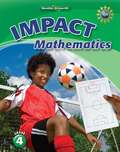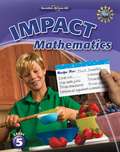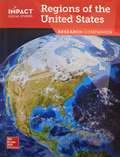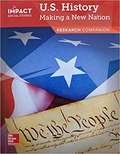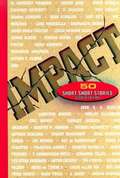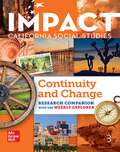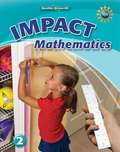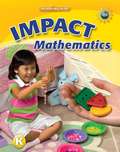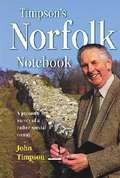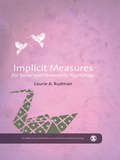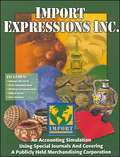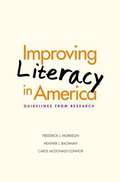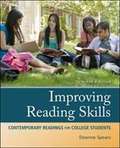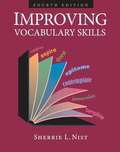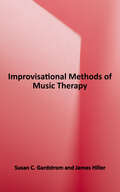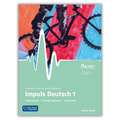- Table View
- List View
Impact Mathematics: Grade 4
by Frances Basich Whitney Robyn Silbey Jane D. Gawronski Viken HovsepianNIMAC-sourced textbook
Impact Mathematics: Grade 5
by Frances Basich Whitney Robyn Silbey Jane D. Gawronski Viken HovsepianNIMAC-sourced textbook
Impact Social Studies: Exploring Who We Are
by McGraw-Hill EducationThe Research Companion is a hard-covered text where students investigate Essential Questions, gather evidence, evaluate primary and secondary sources, consider points of view, experience citizenship and understand how the past shapes the present and future.
Impact Social Studies: Impact Explorer Magazine, U.S. History Making a Nation
by McGraw-Hill EducationNIMAC-sourced textbook
Impact Social Studies: Regions of the United States, Research Companion
by William Deverell James Banks Kevin CollearyNIMAC-sourced textbook
Impact Social Studies: U.S. History: Making a New Nation, Grade 5, Research Companion
by William Deverell James Banks Kevin CollearyNIMAC-sourced textbook
Impact of perceived organizational inclusion of differently abled employees
by Georgia Mickaela G. Aguila Joseph C. Cirineo Kriselle Armi S. Umingan.An abstract of the study entitled "Impact of perceived organizational inclusion on job satisfaction and individual work performance of differently abled employees".
Impact! When an Asteroid Crashed to Earth (Fountas & Pinnell Classroom, Guided Reading Grade 6)
by Steve JenkinsNIMAC-sourced textbook
Impact: 50 Short Short Stories (2nd Edition)
by Holt Rinehart WinstonThe stories in this collection represent a variety of styles: the narrative by Jim Heynen, for example, could be considered a "prose sketch," and the piece by T. Coraghessan Boyle is actually a dramatic monologue. Included are works by writers from a number of different cultures and backgrounds. Good literature provides both pleasure and insight.
Impact: California, Grade 3, Research Companion With the Weekly Explorer, Continuity and Change
by McGraw-Hill EducationThis text serves as the primary source of information and learning to answer the Essential Questions. This is the tool students use to learn the art of research and critical analysis of social studies. Students dig deeper and enhance their learning with the Weekly Explorer Magazine. Articles in various formats explore ideas related to the Essential Questions and provide unique perspectives to extend conceptual development.
Impact: Mathematics, Grade K
by Frances Basich Whitney Robyn Silbey Jane D. Gawronski Viken HovsepianNIMAC-sourced textbook
Implications of Literature: Explorer Level
by Deborah SchechterEnjoyable World Literature anthology designed to stimulate literary, critical thinking, comprehension, and language-arts skills using a variety of literary genres, including short stories, poetry, biography, essays, speeches, drama, a novel, and and Handbooks that reinforce writing and language-arts skills.
Implicit Measures for Social and Personality Psychology (The SAGE Library of Methods in Social and Personality Psychology)
by Laurie A. RudmanIncreasingly used by behavioural and social scientists, implicit measures afford investigating core psychological constructs in ways that bypass people's willingness and ability to report their feelings and beliefs. Focused on two primary assessment tools, evaluative priming and the Implicit Association Test, the Implicit Measures volume is designed for serious practitioners and beginning researchers alike. It provides an overview of each measure, describing its theoretical underpinnings and construct validity. Each chapter then lays out "best practices" for successfully designing each method and analyzing results, revealing how to avoid common pitfalls. The Implicit Measures volume will enable students of implicit measures to decide when and how to use them in their own research, and educate consumers of research about the accomplishments and challenges of using these state-of-the art assessment techniques.<P><P> The SAGE Library in Social and Personality Psychology Methods provides students and researchers with an understanding of the methods and techniques essential to conducting cutting-edge research. <P> Each volume within the Library explains a specific topic and has been written by an active scholar (or scholars) with expertise in that particular methodological domain. Assuming no prior knowledge of the topic, the volumes are clear and accessible for all readers. In each volume, a topic is introduced, applications are discussed, and readers are led step by step through worked examples. In addition, advice about how to interpret and prepare results for publication are presented.
Import Expressions Inc: An Accounting Simulation Using Special Journals and Covering a Publicly Held Merchandising Corporation
by Glencoe/McGraw-HillThis totally redesigned program builds on the content presented in the First-Year Course. Maintaining its real-world focus, this course is designed for both college-bound and vocational students alike.
Imprints class 11 - Meghalaya Board
by Meghalaya Board of School EducationThe book Imprints is an Alternative English subject for Class XI, from Meghalaya Board. The book focuses on enabling the students to become independent readers, honing language skills such as listening, speaking, reading and writing, equipping students with the vocabulary required to function effectively in their professional lives, developing a taste for reading quality material, acquiring analytical and critical thinking and sharpening language skills to be able to cope with learning the other subjects. Lessons have been devised and prepared to take the students from the known to the unknown and to develop communication skills in the young learners preparing them to deal with day-to-day problems and enhance their life experiences.
Imprints class 12 - Meghalaya Board
by Meghalaya Board of School EducationThe book Imprints is an Alternative English subject for Class XII, from Meghalaya Board. The book focuses on enabling the students to become independent readers, honing language skills such as listening, speaking, reading and writing, equipping students with the vocabulary required to function effectively in their professional lives, developing a taste for reading quality material, acquiring analytical and critical thinking and sharpening language skills to be able to cope with learning the other subjects. Lessons have been devised and prepared to take the students from the known to the unknown and to develop communication skills in the young learners preparing them to deal with day-to-day problems and enhance their life experiences.
Improving Literacy in America: Guidelines from Research
by Frederick J. Morrison Heather J. Bachman Carol Mcdonald ConnorAn alarmingly high number of American students continue to lack proficiency in reading, math, and science. The various attempts to address this problem have all too often resulted in "silver bullet" solutions such as reducing class size or implementing voucher programs. But as the authors of this critically important book show, improving literacy also requires an understanding of complex and interrelated social issues that shape a child's learning. More than twenty years of research demonstrate that literacy success is determined by a combination of sociocultural forces including parenting, preschool, classroom instruction, and other factors that have a direct impact on a child's development. Here, Frederick J. Morrison, Heather J. Bachman, and Carol McDonald Connor present the most up-to-date research on the diverse factors that relate to a child's literacy development from preschool through early elementary school. Urging greater emphasis on the immediate sources of influence on children, the authors warn against simple, single solutions that ignore other pivotal aspects of the problem. In a concluding chapter, the authors propose seven specific recommendations for improving literacy--recommendations that can make a real difference in American education.
Improving Reading Skills
by Deanne SpearsNow in its 7th edition, Improving Reading Skills features a wide variety of carefully chosen readings that engage, encourage, and challenge students. Ideal for introductory and intermediate developmental reading courses, this new edition has been thoroughly revised and now includes two new parts, expanded part introductions, an even broader range of levels for the reading selections, increased emphasis on annotating, paragraphing, and summarizing, and a new section in part five.
Improving Vocabulary Skills (4th Edition)
by Sherrie L. NistThe purpose of Improving Vocabulary Skills and the other books in the Townsend Press vocabulary series is to provide a solid, workable answer to the vocabulary problem.
Improvisational Methods of Music Therapy
by James Hiller Susan C. GardstromImprovisational Methods of Music Therapy is the second in a series of textbooks addressing each of the four music therapy methods employed in a variety of clinical contexts. Students and professionals alike will gain foundational knowledge about Clinical Music Improvisation (CMI) and its many variations as pertinent to individual, dyadic, and group improvisation. <p><p> This book is specifically intended as a general roadmap for the design and implementation of therapeutically relevant, effective, and individualized improvisation experiences applicable to a wide range of clinical profiles and interpersonal and cultural contexts. As such, Improvisational Methods of Music Therapy addresses prerequisites, risks, contraindications, inherent affordances, and challenges related to CMI, with overarching considerations and procedural steps for Instrumental, Vocal, and Body Improvisation. Attention is given to the use of CMI toward both client achievement of predetermined and measurable therapeutic objectives (i.e., outcome-oriented practice) and client identification and exploration of needs as they manifest in the musicing process (i.e., experience-oriented practice). Hypothetical case illustrations and summaries of actual clinical cases highlight particular CMI variations and procedures.
Impuls Deutsch 1
by Nicole Coleman Niko Tracksdorf Damon Rarick Friedemann WeidauerThe IMPULS DEUTSCH 1 textbook can help beginner German language learners achieve novice-high proficiency in just two semesters. This exciting and innovative resource features fresh and sophisticated content from the arts, humanities, and STEM fields, providing a well-rounded and engaging learning experience.
